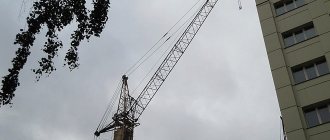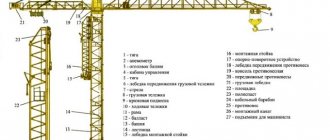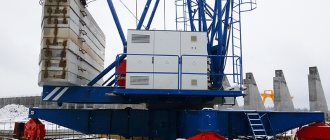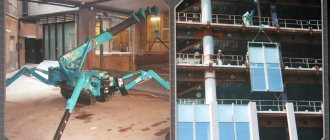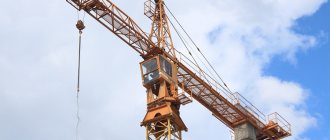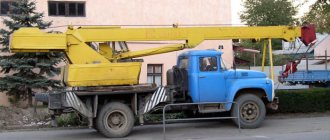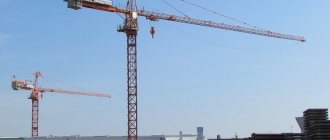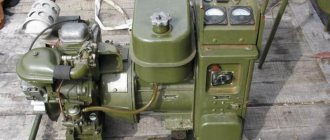Scope of application
With the help of KB-403 (alternative designation Kbk-160.2), all installation and construction work became mechanized.
KB-403 is also used in grain elevators and industrial enterprises , factories and power plants .
Lifting height of heavy weights up to 8 tons = 57.5 m. The crane performs all vertical and horizontal movements of building structures and materials at the work site to the desired location.
Installation of a tower unit on a construction site
The installation of a tower crane on a construction site begins with a rail base. KB-403 uses rails marked P43/P50. Using a truck crane, the chassis is installed and the tower is lifted (the tower can also be lifted using its own mechanisms). Further work consists of hanging and fixing the boom. Workers then begin building up the tower's inventory sections through the portal.
Requirements for organizing and carrying out crane installation work
Main technical characteristics
The modernization of beam cranes of the 4th size group was carried out at the Nyazepetrovsky ZSM and at the Moscow PA Stroymash. Changes in the design affected a number of important components, and the technical characteristics of the KB-403 cranes took their current form.
Table of technical characteristics of the tower unit:
| Characteristic | Index |
| Special vehicle model | tower, rail travel |
| Boom model | beam |
| Load capacity at maximum horizontal boom reach | 3–3.5 tons |
| With a maximum outreach of the inclined boom at 30 degrees | 3.7–4.5 tons |
| Max. lifting capacity | 8 tons |
| Load moment | 120–130 t.m |
| Wheel pressure on rail | 270 kN |
| Input voltage value | 380 V |
| Engine power | 116–120 kW |
| Lowering depth | 5 m |
| Crane height | 37,9–54,76 |
| Track width | 6 m |
| Inventory section size | 1.8 m |
| Number of inventory sections | Up to 5 |
| Counterweight mass | 30 t |
| Crane weight | 76,6–80,5 |
| Rotary module radius | 3.8 m |
| Cart speed | 30 m/min |
| Movement speed (max) | 18 m/min |
| Hook lifting speed (max.) | 55 m/min |
| Boom lift height | 35.4 m |
| Swivel power | 5 kW |
Design features of tower crane KB 403
About technology
Tower crane KB-100. Self-propelled tower cranes, designation of modifications: KB-307, KB-303, KB-302, KB-301. Designed for the construction of buildings up to 9 floors high. Load capacity 5 tons, Load moment 100 t m. The tower is rotating and lifting.
KB-100 are produced by the Rzhev Crane Manufacturing Plant. In 1965, factories in the cities of Uryupinsk and Rustavi (Georgian SSR) began producing a modification of the KB-100.1, with the same characteristics. But this model was slightly different in design - instead of a lattice crane, it had a tubular metal structure. Already in 1967, Georgian specialists, based on the serial crane KB-100.1, mastered the production of the next modification - KBk-100.1. The crane, developed by Central Design Bureau "Stroymash" (Leningrad), had unified components and mechanisms with the serial crane, and also differed in the design of the working boom - the new model used a beam boom (lattice structure). In addition, thanks to the sectional nature of the boom, it was possible to retrofit it with one intermediate section, which increased its reach from 20 meters to 25 m. Later, the Monchegorsk Mechanical Plant mastered the production of the KB-100.2 model with a sectional tower of a telescopic design. And at the Rustavi Crane Manufacturing Plant, the production of the KB-100.3 crane with a lifting capacity of 8 tons, intended for the construction of 9-story buildings and structures, was launched. In addition, the Ukhta Mechanical Plant has produced and is still producing crane modifications intended for use in the Far North - at ambient temperatures down to −60 °C and wind speeds up to 20 m/sec. Currently, UMZ produces modifications under the designations KB-309. The Monchegorsk plant also produces cranes under the symbol CK-3861 - both jib and cranes for the construction of zero cycles.
This is interesting: How to make a crane beam for a garage with your own hands: let’s take a closer look
Device KB-403
- The tower is a rotating lattice tower with adjustable height. It consists of retractable sections, the head section is collapsible.
- The KB-403 turret grown
- The boom is a lattice single-hung sectional beam, it is a triangular truss along which the trolley moves.
- The cargo trolley is secured with hinges and cables and is designed for transporting materials and parts.
- The rotating platform is a flat device on which the portal is mounted. At the top front are the support hinge eyes. On the side there are cabinets with controllers and starters. At the rear, rods are welded to the transverse beam, onto which the jib pulley is attached. Ballast slabs weighing 30 tons are laid on the transverse beams.
The main devices of the crane are located on the platform: the turning mechanism, winches (cargo and jib). On both sides, 2 counterweight blocks are secured with steel pins.
The support for the turntable is the running frame; they are connected using a support gear. The rotating mechanism on KB-403 is a roller circle (in 1 row), diameter = 2.5 m.
- The portal is mounted on a rotating platform, open at the top and bottom for the passage of tower sections.
- The rope system is equipped with pulley blocks.
- The mechanism can be controlled from the cabin and from the ground.
Building up
Extension operations:
- The mounting cross-beam is attached to special fastenings of the hook cage using chains.
- The fastenings of the elevator and the intermediate section of the tower that follows it are disconnected, then, using an assembly winch, the stand is raised to the level of the crane head.
- Using a traverse, the next intermediate section of the tower is captured and raised to the installation level.
- A new intermediate section of the tower is mounted into the opened space using a traverse using a cargo trolley.
- The top of the tower is then lowered onto the new section, the sections are joined and the crane can operate at an increased lifting height.
In the case of attaching a crane to a building under construction, the corresponding sections are provided with embedded frames that are installed at the junction of two sections. Mounting to the house is similar to the KB-573 crane.
Characteristics of the main components
KB-403 tower is rotatable, which makes the crane easy to use on any construction site. The lattice design of the tower minimizes its overall weight. Unlike previous models, the head section of the tower here is collapsible.
Tower crane KB-403
boom is a beam type, has a classic triangular truss, and consists of sections that are attached to each other with flange connections. The boom reach can be changed by tilting it or moving the load trolley.
Strela KB 403
The load trolley moves along the entire length of the boom and is used for lifting and moving loads on a construction site. For this purpose, the trolley design is equipped with cables.
Cargo trolley KB-403
The turntable also has some differences from older models. The KB-403 turret rotation mechanism is a roller circle with a diameter of 2.5 meters. A portal is mounted on the plane of the turntable. At the rear, the transverse beam is equipped with rods to which a system of jib pulley blocks is attached. Counterweight slabs weighing 30 tons are placed on the transverse beams. On the side there are cabinets with a starter and controllers. A running frame is used as a support for the turntable.
The portal is necessary for expanding tower sections. The design of the KB-403 crane provides for the expansion of inventory sections in the amount of two to five units, which allows the boom to be raised to the maximum height of a sixteen-story building. The portal can be opened to receive sections from both the top and bottom.
The rope system of the tower unit is equipped with block systems (pulley hoists).
Cabin Feature
The cabin is the main control point of the tower crane. Controllers, levers and switches responsible for raising and lowering the boom, trolley movement, hook operations and other functions are located here. The well-glazed cabin of the KB-403 allows the operator to observe the work and control the situation without interference. For comfortable work, the interior lining of the cabin reduces vibration of the crane and blocks external noise.
An anti-corrosion protective layer is used on the outside of the cabin, thanks to which the module is not afraid of the vagaries of nature. To operate in the cold season, the tower crane cabin is equipped with a heating system.
Safety system
The safety device will prevent an accident from occurring. The KB-403 tower crane is equipped with all the necessary sensors and other measuring instruments that will react in time to the unacceptable weight of the load being lifted and warn the operator about this using an audible signal. The system will automatically block further lifting of the boom or hook cage to avoid a dangerous situation.
Design features
- Developed on the basis of the KB-160 product, which has proven itself in construction and is technologically proven. At the same time, the KB-408 has become a more advanced vehicle structurally and has a number of important differences from its predecessor.
- Refers to the mobile or mobile type of tower cranes. Using an electric drive, it can move autonomously around a construction site within specified limits.
- For movement, KB-408 has rail-mounted trolleys. The movement of the crane structure is controlled from the operator's cabin. The organization of crane tracks is typical for this type of special equipment.
- The basis for the tower is the portal. Its design is identical to that used on the KB-160. The portal includes an upper frame, racks and lower longitudinal beams associated with them. There are holes in the beams for the pins of the running bogies.
- The running frame is made according to the scheme with rotary weather vanes. It is traditional for this type of special equipment and structurally completely copies the frame of the KB-401 and KB-402 products.
- The tower is rotating. The crane structure is capable of rotating around a vertical axis 360 degrees, that is, it makes a full turn. The rotating platform is similar to that used on the KB-160. The turning mechanism is different. It is made of roller, single-row.
Tower:
- Consists of 2 - 5 modules. The number of sections varies from 33 to 56 depending on the design. The turret elements are unified in many respects with the KB-160, which facilitates access to spare parts and simplifies maintenance and repair of the product.
- The technological development of KB-408 in comparison with the prototype was an increase in the number of modular structures. Depending on the design and wishes of the customer, the tower can have from two to five sections, and in some cases six. Increasing the number of modules simplifies transportation and installation.
- The design of the KB-408 head section also received changes. It is made collapsible - this is another improvement of the KB-160 product. In the new version, the head is easier to transport and install on the product. In addition, the number of pulley ropes installed on the head has changed.
Arrow:
- Beam type, made according to the traditional design with a cargo trolley. Capable of deviating from a horizontal position by an angle of up to 30 degrees, changing the load capacity and lifting height of the load.
- Technologically it consists of detachable sections. Their number is determined by the execution and varies in the range from 30 to 50. The boom sections are designed in the form of classic lattice trusses made of high strength pipes. The sections are connected using flanged surfaces.
- During installation, the KB-408 boom part can be installed in an inclined position, which simplifies the process and reduces assembly time.
- The boom reach can be adjusted by moving the load trolley along the boom section and changing the tilt of the boom.
Cabin:
A fundamental improvement of the KB-408 in comparison with its predecessor was the use of a special cabin for high-altitude crane equipment. It can be installed at a height of more than 20 meters. The cabin installation technology is the same as on other cranes of this size range, which simplifies the operation of the crane and unifies the requirements for personnel. The cabin has been improved in comparison with the base model in a number of ways
The designers paid the most serious attention to the ergonomics of the operator's workplace. The KB-408 cabin is equipped with a modern safety system and warns the operator about the possible occurrence of a critical situation.
The cabin heating system has been completely changed. For these purposes, the designers used innovative type heating panels. The cabin provides the possibility of installing an air conditioner. It is installed at the request of the customer.
Cargo device:
- The hook cage is structurally designed as a biaxial suspension. Traverses, blocks and a hook are installed on its axles.
- The hook cage is equipped with external protective covers. Their purpose is to protect the hook cage blocks from accidental impacts when hooking a load.
Modifications
At the moment, there are several modifications of the basic model of the KB-403 tower crane, these are:
- KB-403A , which is distinguished by lifting up to the 16th floor, more convenient and easier control from a structurally improved cabin, increased lifting and movement speeds of the loading trolley, as well as greater stability with an increased load moment.
- KB-403B , designed for lifting loads on buildings up to 17 floors. It has a larger boom radius and is available in 4 variants with different load torque (from 120 to 132), total height, boom radius, etc. It is distinguished by its reliable design and ease of maintenance.
- KB-403B.4 is used in lifting loads up to 35.4 m. It has an increased boom reach and load moment.
Comparative characteristics of the models:
| Options | KB-403A | KB-403B | KB-403B.4 |
| Structural weight, t | 50 | 50,5 | 46,6 |
| Total weight, t | 80 | 80,5 | |
| Track, m | 6 | 6 | |
| Load moment, t*m | 132 | 120 | 132 |
| Maximum load capacity, t | 8 | 8 | 8 |
| Load lifting at full boom reach, t | 4,5 | 3 | 3 |
| Maximum boom radius, m | 25 | 30 | 30 |
| Boom radius with max. load, m | 16,5 | 15 | 16,5 |
| Lifting height at full reach, m 41 | 41 | 41 | 24,2 |
| Maximum lift, m | 52 | 54,7 | 37,9 |
| Landing speed, m/min | 4,8 | 5 | 5 |
| Lifting speed max. load, m/min | 40 | 40 | 40 |
| Maximum lifting speed, m/min | 58 | 55 | 55 |
| The highest speed of the chassis | 18 | 18 | 18 |
| Speed of movement of a filled cart | 23 | 30 | 30 |
| Rotation speed, rpm | 0,6 | 0,65 | 0,65 |
| Possible degree of wind gust | IV | III | VII |

